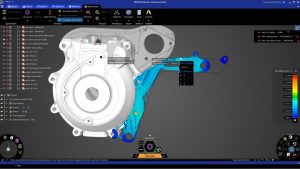Introduction
In the ever-evolving landscape of engineering and product design, precision and accuracy are paramount. From aerospace and automotive industries to electronics and consumer goods, engineers face a growing need to simulate, analyze, and optimize their products before they even hit the drawing board. This is where ANSYS, a powerful simulation software suite, enters the scene. In this article, we will delve into the world of ANSYS and explore how it empowers engineers to unlock innovation and achieve engineering excellence.

The Power of Simulation
Simulation has become a cornerstone in modern engineering practices. It enables engineers to test and refine their designs in a virtual environment, saving both time and resources while minimizing costly errors. ANSYS, developed by ANSYS, Inc., is a world-renowned simulation software that offers a comprehensive set of tools for engineers across various industries. Let’s take a closer look at this remarkable software and its capabilities.
The Versatility of ANSYS
- Finite Element Analysis (FEA)
At the core of ANSYS lies finite element analysis. FEA enables engineers to simulate the behavior of complex structures, from mechanical components to entire buildings. ANSYS simplifies the FEA process, allowing engineers to perform structural analysis, thermal analysis, and even modal analysis to understand how a structure will respond to different conditions.
- Computational Fluid Dynamics (CFD)
ANSYS is a leading choice for CFD simulations. Engineers in the aerospace, automotive, and energy sectors rely on ANSYS to analyze the fluid flow, heat transfer, and chemical reactions within their systems. This capability is essential for designing and optimizing everything from aircraft wings to internal combustion engines.
- Electromagnetics and Electronics
The software extends its capabilities to electromagnetic simulations. Engineers in the electronics industry use ANSYS to analyze electromagnetic fields, ensuring optimal signal integrity and minimizing interference. This is crucial for developing high-performance electronic devices and systems.
- Multiphysics Simulations
In the real world, many physical phenomena interact with each other. ANSYS allows for multiphysics simulations, where different domains (such as structural, thermal, and electromagnetic) can be coupled to assess how they influence each other. This is particularly valuable for developing advanced technologies like electric vehicles.
Applications of ANSYS
- Aerospace Industry
The aerospace industry is synonymous with precision, and ANSYS plays a crucial role in ensuring the safety and performance of aircraft. It helps engineers simulate the structural integrity of aircraft components, assess aerodynamics, and analyze the thermal properties of spacecraft.
- Automotive Engineering
In the highly competitive automotive industry, ANSYS aids in optimizing vehicle designs for safety, fuel efficiency, and performance. It enables engineers to perform crash simulations, study aerodynamics, and evaluate engine performance under various conditions.
- Energy and Renewable Resources
ANSYS is a vital tool for the energy sector. Whether it’s optimizing wind turbine designs, analyzing the behavior of nuclear reactors, or evaluating the performance of solar panels, ANSYS helps in harnessing energy more efficiently and sustainably.
- Electronics and Semiconductor Industry
Electronics are getting smaller and more powerful, and ANSYS is at the forefront of ensuring their reliability and performance. It helps engineers analyze the thermal properties of electronic components, assess electromagnetic interference, and optimize semiconductor manufacturing processes.
- Biomedical Engineering
ANSYS is also making significant contributions to biomedical engineering. It’s used to simulate the behavior of medical devices, assess the impact of orthopedic implants on the human body, and optimize the design of prosthetics.
ANSYS in Action
Let’s consider a practical example of how ANSYS can revolutionize product development.
Scenario: Designing a Safer Car
Imagine a team of automotive engineers tasked with designing a safer car. They want to understand how different materials and structural configurations will impact the vehicle’s crashworthiness. Using ANSYS, they can create detailed finite element models of the car’s components, including the chassis, body, and airbag systems.
- Crash Simulation: The engineers set up a crash simulation, where the car collides with a barrier at various speeds and angles. ANSYS accurately predicts the impact forces and deformations, enabling the team to make design changes that enhance occupant safety.
- Airbag Deployment: By coupling structural analysis with fluid dynamics simulations, ANSYS can model the deployment of airbags during a collision. This ensures that the airbags inflate at the right time and with the correct force to protect the occupants.
- Material Selection: ANSYS provides material libraries and tools for evaluating different materials’ properties. Engineers can assess the impact of using lightweight materials, such as composites, on the car’s structural integrity and fuel efficiency.
- Optimizing the Design: Through iterative simulations and analysis, the engineers fine-tune the car’s design to meet safety regulations and achieve superior performance.
The end result is a car that has undergone rigorous virtual testing, significantly reducing the need for physical prototypes and testing, which can be time-consuming and expensive.
Advantages of ANSYS
- Accuracy: ANSYS is renowned for its high-fidelity simulations that closely replicate real-world conditions, giving engineers confidence in their designs.
- Efficiency: By allowing engineers to simulate and optimize designs in the virtual realm, ANSYS reduces the time and cost associated with physical testing.
- Innovation: The software encourages innovation by enabling engineers to explore new design concepts without the risk of costly failures.
- Interdisciplinary Analysis: ANSYS’s multiphysics capabilities enable engineers to analyze the complex interactions between various physical phenomena, such as fluid-structure interactions or thermal-electromagnetic coupling.
Challenges and Considerations
- Learning Curve: ANSYS is a sophisticated software suite, and mastering it can be time-consuming. Engineers may need dedicated training and experience to use it effectively.
- Hardware Requirements: Running complex simulations demands powerful hardware, which can be costly.
- Cost: ANSYS is not a budget-friendly option for small businesses or startups. Licensing costs and ongoing maintenance can be significant.
The Future of ANSYS
ANSYS continues to evolve with advancements in technology. Here are some trends and developments in the world of simulation and ANSYS:
- AI and Machine Learning: ANSYS is integrating artificial intelligence and machine learning to accelerate simulations and provide engineers with real-time insights into their designs.
- Digital Twins: The concept of creating digital twins of physical systems is gaining momentum. ANSYS plays a pivotal role in developing and validating these digital replicas, allowing for better predictive maintenance and optimization.
- Cloud Computing: ANSYS is moving towards cloud-based solutions, making it more accessible and scalable for a broader range of users.
Conclusion
In the realm of engineering, ANSYS stands as a powerful tool allowing engineers to innovate and design with confidence. Its versatility, accuracy, and efficiency make it an indispensable tool for industries ranging from aerospace to automotive, energy to electronics. As technology continues to advance, ANSYS will play a pivotal role in shaping the products and systems that drive our modern world, ensuring that engineering excellence is not just a goal but a reality.


